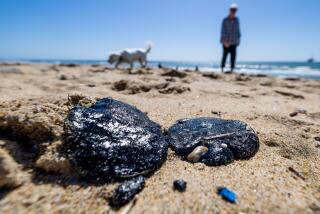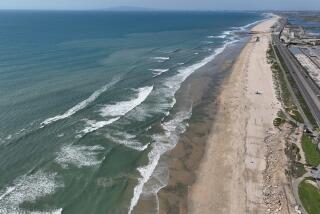Painstaking Efforts Expose Stateâs Largest Oil Spill : Pollution: Unocal admits problems over 40-year period. Firm is taking more extensive cleanup measures.
GUADALUPE, Calif. â Kathy Johannes remembers the winter of 1988 in vivid detail: Dozens of seals and sea lions struggled ashore and suffered fatal seizures on the beaches of Central California.
The animals all had an oily sheen, and beneath their fur she could see that their skin was inflamed. Soon, the volunteer animal rescue worker became convinced that the deaths were linked to frequent oily discharges from the Unocal Corp. oil field on the sand dunes of Guadalupe.
But the Los Angeles based-company denied that it had spilled any oil, and local authorities declined to take action. âIn 1988 we were telling them there was a problem and nobody listened,â Johannes said. âNobody did anything about it.â
Now, thanks largely to a new state agency funded by a tax on oil companies, Unocalâs pollution problems at the Guadalupe field are no longer being ignored. Evidence painstakingly collected by the state Office of Oil Spill Prevention and Response shows that for 15 years, some Unocal employees sought to cover up what has become the largest petroleum spill in California history.
State investigators found that as far back as 1978, employees at the field were told not to call attention to repeated spills of diluent, a petroleum thinner used in large quantities to dilute Guadalupeâs heavy crude oil.
When one diluent spill formed an oil slick 4 1/2 miles long on the ocean in 1986, Unocal remained silent. When questioned about another ocean spill in 1988, the company produced laboratory tests incorrectly showing that Unocal was not to blame. Under state law, oil companies must report any petroleum spill immediately.
âUnocal misstated the facts in a way that the government regulators were misled about the true nature of the pollution problem,â said warden Allen N. Huckaby, the dogged investigator for the oil spill agency who helped break open the case.
Finally, Unocal acknowledged this month that it has leaked up to 8.5 million gallons of the clear, diesel-like fluid into the ground in a series of discharges and pipeline breaks over 40 years. The company pleaded no contest last week to three misdemeanor pollution charges--including failing to report ocean spills--and was ordered to pay $1.5 million in penalties.
Top Unocal officials, embarrassed by the revelations, insist that they were shocked to learn of the magnitude of the spill and disappointed by the failure of employees to notify authorities when leaks occurred.
Executive Vice President John F. Imle Jr., who personally entered the companyâs no contest plea in court, insisted that the firmâs highest levels of management never ordered a cover-up. But he conceded that workers at the aging oil field, worried that pollution problems could shut down the operation, may have kept the spills quiet to protect their jobs.
Authorities uncovered no evidence that top officials of the company helped conceal the spills.
âI can assure you there was never an institutional cover-up,â Imle said. âSomewhere in the system, we dropped the ball. . . . We will review our own procedures to see where they broke down.â
Leased by Unocal since the early 1950s, the oil field is spread among the sand dunes at the southern edge of San Luis Obispo County, a mile from the little town of Guadalupe.
The beach, where the fieldâs first wells were drilled, is the site of Unocalâs greatest problems.
Even on the best of days, the odor of diluent rises from the sand. Beneath the beach, diluent from numerous spills sits on top of the ground water in an underground pool.
On the worst of days--usually during winter high tides--the ocean scours away the sand down to the water table and washes the diluent into the ocean, where it poses a hazard to surfers and aquatic life.
Some surfers say they have suffered rashes from exposure to the diluent. One group of surfers has notified Unocal that it intends to sue the company under Proposition 65, which requires businesses to warn the public of exposure to cancer-causing chemicals.
In addition to the marine mammals recovered by Johannes, wildlife experts question what kind of damage the leaks have done to marine creatures, particularly the Pismo clam, found four miles north at Pismo Beach.
During the last decade, there have been years when the clams have produced virtually no offspring. Biologists have generally attributed the unusual reproductive pattern to ocean currents and the voracious appetite of the sea otter. But Unocal officials say they plan to study whether the spills could have been responsible.
âSo far, we have seen no evidence to connect it, but itâs not conclusive,â said Marjorie Hatter, who was recently assigned by Unocal to head the cleanup effort. âWe have a lot more work to do.â
Farther inland under the oil field, test wells have found greater concentrations of diluent floating on top of ground water. Altogether, there are 28 plumes of the fluid, with the largest concentration near tanks used to store and distribute the diluent for 35 years.
If not for the repeated seepage of diluent into the ocean, the massive spill--caused by broken pipelines, overflowing tanks and careless handling of the cheap and plentiful liquid--might have gone unnoticed for many more years. Spilled diluent usually soaked quickly into the sandy, porous ground without leaving visible signs. Ground water beneath the oil field is not used for drinking, so the contamination did not surface in wells.
But in the winter of 1990, a major ocean spill forced the company to acknowledge that the petroleum was coming from its oil field.
The company stopped using diluent, shut down most oil production at the field, installed wells on the beach to pump out the fluid and built a submerged seawall in an unsuccessful attempt to stop further ocean spills. But the company still did not acknowledge the full extent of the leaks at the field.
It was not until 1993--after the oil spill agency had seized some of Unocalâs records and ordered the company to drill a dozen test wells--that the company admitted there was contamination throughout the oil field.
âUntil then, I donât think anyone (outside Unocal) even had a remote indication there was this kind of a problem,â said Stephen L. Sawyer, a lawyer with the Office of Oil Spill Prevention and Response. âThe pattern of failing to report is the (heart) of the offense. If they had reported as required, all the leaks throughout the field might not have occurred.â
The oil spill agency, which was created by the Legislature after the Huntington Beach oil spill of 1989, is preparing to file a civil suit this week seeking penalties of as much as $170 million from Unocal.
Now, with the end of the criminal case against the company, the Guadalupe oil field is being transformed into a cleanup site.
In one part of the field, workers are drilling wells in a pilot project to see how effectively they can recover diluent floating on the ground water. Elsewhere, experts are taking carbon dioxide measurements and sinking test probes to map out the location of the contamination.
Recognizing that its earlier beach cleanup efforts failed, Unocal is proposing to stop the ocean spills once and for all this spring by excavating the beach several feet down to the water table, installing a wall farther inland to halt the migration of diluent, and replacing the beach with clean sand.
Elsewhere in the oil field, the company proposes to drill wells to pump up the diluent, recovering about 30% of what is there. Then they plan to rely on bacteria to consume the rest of the product, pumping oxygen and moisture into the ground to accelerate the natural process. The entire project could take five years. Within the same period, Unocal plans to halt production and remove all traces of the wells above ground.
Imle, who is a member of Unocalâs board of directors, said he wished that employees had come to him long ago with reports of the spill.
Now, he says, the message has been delivered loud and clear that employees must comply with reporting laws. âThe standard today is, you spill a drop of diluent or anything else in that field and you tell somebody about it,â he said.
According to evidence compiled by the state oil spill agency, Imleâs philosophy was not the rule from 1978 to 1993. In a report filed last week with the San Luis Obispo district attorneyâs office, Huckaby, the investigating agent, documented some of the efforts by Unocal employees to cover up spills.
In 1986, an employee named John Smith suggested installing a pump to collect diluent that was floating on top of the ground water in a shallow hole near the beach. His proposal was rejected by a foreman who told him: âWe donât want anybody to know we know this is here,â according to Huckabyâs report. Shortly afterward, the foreman ordered the hole filled in.
Smith later became a key figure in the case after he called the state agency anonymously in 1992 to report that Unocal was attempting to cover up another major leak. His call led to a search warrant and raid of Unocal offices in which agents seized numerous company records and began to unravel the cover-up.
Another incident cited by Huckaby occurred in the winter of 1988, when diluent entered the ocean in such quantities that residents of the area complained of oil pollution at Guadalupe Beach, just south of the oil field.
Unocal took samples of the spilled oil and reported that it did not match diluent used at the field. The company suggested that the oil had come from a passing ship that discharged fuel.
Charging that Unocal collected bogus samples, Huckaby wrote: âIt is clear Unocal lied to or deliberately misled (local authorities) concerning the oil contamination to the beach and surf.â
It was during the three months after this spill that Johannes, the animal rescue worker, recovered 72 dying or dead sea lions and seals, according to her records. She said she also found dead marine mammals after spills in 1989, 1990 and 1992.
Despite her repeated pleas, local authorities were unwilling to take on Unocal in the face of the companyâs denials, she said. Finally, she became so frustrated she turned in her federal permit for rescue work, saying she no longer wanted to be an accomplice to the oil companyâs pollution.
âI was running around picking up animals for five years,â Johannes said. âIâm very angry about it. They owe that money (court penalties) in a big way because they ignored the animals. Theyâve been covering this up for years.â
Record Spills
The total volume of petroleum thinner spilled at the Guadalupe oil field ranks it as one of the largest oil spills in the nation. These are the top 10 petroleum spills reported in the United States during the past 25 years:
* 1. The Corinthos, a ship carrying Algerian crude oil, was rammed by another ship while offloading oil in Pennsylvaniaâs Delaware River in January, 1975. Thirty-eight people died. Total spill: 11.2 million gallons.
* 2. The Burmah Agate, a Liberian ship, exploded after colliding with another ship at the entrance to Galveston Harbor, Tex., in November, 1979. Total spill: 10.7 million gallons.
* 3. The Exxon Valdez ran aground in Prince William Sound, Alaska, in March, 1989. Total spill: 10.1 million gallons.
* 4. Petroleum thinner spilled at the Unocal oil field near Guadalupe, Calif., during hundreds of pipeline breaks and leaks over four decades of operations. Total spill: estimated up to 8.5 million gallons.
* 5. The Argo Merchant, a Liberian tanker, went aground near Nantucket, Mass., in December, 1976. Total spill: 7.7 million gallons.
* 6. Waste oil and sludge spilled into the Schuylkill River, Pa., in June, 1972, from a reclamation plant during floods from Hurricane Agnes. Total spill: 7.1 million gallons.
* 7. An offshore oil well near Santa Barbara operated by Union Oil (now Unocal) blew out in January, 1969. Total spill: 4.2 million gallons.
* 8. Oil escaped during maintenance at the U.S. Strategic Petroleum Reserve, Pa., in September, 1978. Total spill: 3 million gallons.
* 9. The tanker vessel Alvenus ran aground off Louisiana in July, 1984. Total spill: 2.7 million gallons.
* 10. A Chevron oil platform off Mississippi caught fire, spilling oil and gas, in February, 1970. Total spill: 2.7 million gallons.
Sources: U.S. Department of Commerce and Times files
More to Read
Sign up for Essential California
The most important California stories and recommendations in your inbox every morning.
You may occasionally receive promotional content from the Los Angeles Times.










